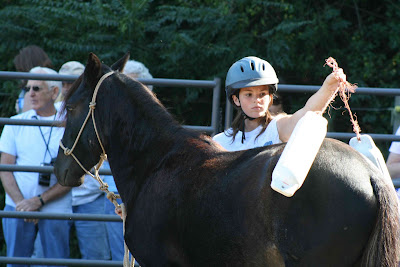
We pause now from our discussion of natural horse care to reflect a bit on the last year at the horse lot. I am a very poor keeper of records. By January 1 we will have all eligible horses registered with the Horse of the Americas Registry and the American Indian Horse Registry so that my little riders (and the grown ones) can receive credit for their accomplishments with their horses. For now I will search my memory and list some of those accomplishments for the year 2008.
Training:
Brenna, Riley, Jacob, JK, Amanda and Lea all got horses broke and in the woods this summer. In addition,we broke Persa and Wanchese, (Shacklefords)and two other Corollas. Danielle greatly improved her knowledge and skill in training over the year.
Rider Accomplishments:
Sarah Lin, Theresa, Chance, Kay, Jacob, Jordan, Lea,Rylee and Amanda each advanced to the Hard Riders who ride longer, faster and through rougher conditions than those new to riding.
Robert and Katie, and another Katie, Wendy, and Loretta canter confidently.
Liz rode a Corolla mare forty six miles in one day, less than thirty days after the horse was captured. The Forty Six Mile ride is detailed in a previous post entitled "On Glory Road."
Five of my riders acquired new HOA or AIHR horses.
Press:
One TV interview regarding my book and the Corollas.
Feature article in Virginia Sportsman.
Articles in several papers concerning the birth of the first pure Corolla from the offsite breeding program.
Promotions and Events
We took several Corollas to the Dare County July 4 Parade and rode the wild horses quite well.
We did clinics and demonstrations at the Delaware Horse Expo and the annual meeting of the Horse of the Americas Registry.
We took Corollas out to events at two tack shops.
Kay Kerr developed a great program in which she has taught several riders to produce beautiful art works whose sale proceeds will go to the Corolla Wild Horse Fund.
Some of my riders were in the local Christmas parade and most of my riders rode on the September 20 Forty Six Mile Ride.
Of course, we continued our policy of holding open house colt starting sessions on Saturday afternoons in which the general public gets an opportunity to see natural horsemanship at work.
Chas is getting his Eagle Scout recognition for construction work that he is doing to assist in our efforts to keep the Corollas in front of the public.
Katelynn continues to use her tremendous writing skills to promote the Corollas.
Rebecca put a great deal of work into designing our horse training enclosure that Sarah Lin named the Amusement Park. (I hope that you will be seeing great pictures of the Amusement Park in use this Spring)
Awards and Honors
For our work to protect and promote the wild horses of Corolla we received the Keeper of the Flame Award from the American Indian Horse Registry and Brent received a miles ridden recognition from the AIHR.
Team Work
The kids love the horses and riding. I do too, but what touches me the most is the amount of enthusiastic support and hard work that we get from the families of my little riders. They are the answer to the question, "How do you run all this by yourself?" I do not. And that means an awful lot to me.
I am absolutely certain that I have forgotten to mention many significant accomplishments of a lot of my riders and their families. For every one in our program, if I left you out, please set the record straight with a comment.
Remember, according to that wii machine, I am too old to be expected to remember any of this stuff.




































